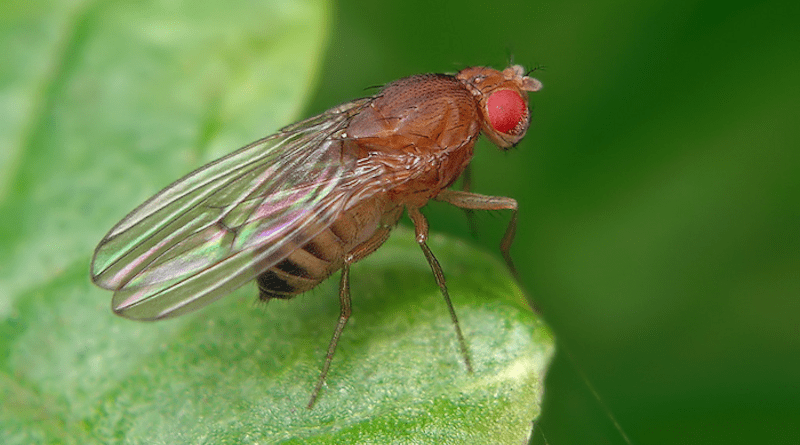Fruit Flies Feast For Pleasure As Well As Necessity
Researchers have begun to explore the underlying neural activity of eating behaviours in fruit flies to better understand the motives that drive feeding.
Their study, published as a Reviewed Preprint in eLife, provides what the editors say is compelling evidence that fruit flies, like people, can eat for pleasure as well as out of necessity. It also offers a framework for further exploring the neural mechanisms behind these hunger drives.
All animals and humans experience hunger. It can be generated by two drives: the need to consume nutrients, such as those provided by a healthy breakfast, and the pleasure that certain foods, such as tasty delicacies, can give us. Decades of research have provided detailed information on brain circuits and mechanisms that control feeding behaviours, but it is unclear which of these contribute to the generation of different motivations to feed.
“In humans, self-reported degrees of hunger are usually poor predictors of the amount of food we actually eat, which has made it difficult to measure and study hunger drives. To better understand the motivations behind feeding in humans and animals, we need to move beyond measures of food intake or foraging behaviour alone,” says first author Kristina Weaver, a graduate student at senior author Scott Pletcher’s lab, University of Michigan Medical School, US. “We need new and complementary methods to explore when and to what degree animals may experience different types of hunger.”
To address this gap, Weaver and colleagues began by defining the feeding behaviours of the fruit fly Drosophila melanogaster at different hunger states. They placed freely moving flies in feeding chambers of the Fly Liquid Interaction Counter system, which allows users to continuously record individual flies’ interactions with food. To record the greatest variety of behaviours, they included flies ranging from 5–20 days old; female and male sated and starved flies; flies housed singly or in groups of up to three; and flies interacting with 5% or 10% sucrose (sugar) food. They recorded 50 flies and over 1,500 separate feeding ‘events’, defined by a continuous set of behaviours that could be separated by intervals of longer than one second in which a fly was not engaging in any observable behaviour. Using their observations, the team then created a library of behaviours that describe what flies do when they eat and classified them into four categories: long feeding events, fast feeding events, interaction events, and other.
After establishing that hungry flies increase the duration of their feeding events as well as the total number of events, they then set out to identify distinct hunger drives using these behaviours. To do this, they designed two types of food choice environments: one to observe need-driven feeding in the flies and one for pleasure-driven feeding.
Need-driven feeding in fruit flies is thought to be measured by the extent to which they choose to eat a yeast-containing food over one consisting of sucrose only. So, the team exposed flies to a meal choice of either 2% sucrose or yeast food, and analysed their relative interactions with the yeast food. They found that starved female flies had a greater preference for yeast compared to fully fed female flies, confirming that the total number of feeding events with yeast versus sucrose can be used as a measure of need-driven hunger. There was also a higher preference for yeast in fully-fed female flies compared to males, which may reflect a known difference in protein requirements, and therefore need-driven hunger levels, between female and male flies.
To measure pleasure-based drive, the team exposed fully fed female and male flies to the same environment again, but with the exception that the 2% sucrose food was replaced with a sweeter 20% sucrose meal. They found that both the female and male flies in this environment spent significantly more time interacting with the pleasurable 20% sucrose compared to the 2% sucrose meal. These, combined with further observations of the flies’ feeding micro-behaviours, suggest that they can experience both pleasure and need-based feeding drives.
Next, the team imaged the brains of flies in the 20% sucrose environment and found that specific lobes of a region called the mushroom body were activated by this environment. As the mushroom body is supplied by dopaminergic neurons that are thought to contribute to food reinforcement, these findings support prior knowledge about its role in feeding motivation and reward.
“We have identified both pleasure and need-driven hunger states in flies, and developed an effective behavioural classification system to help measure them,” Weaver says. “Together, this work offers a framework for us and others to begin dissecting the molecular and circuit mechanisms that generate these motivational states in the brain.”
One limitation of the study is that most feeding data are gathered from the interactions of individual flies with a source of food, defined as physical contact with the food for a certain amount of time. Measuring feeding in tiny flies is challenging and, over the years, different devices and approaches have been developed to do this. Despite this, the debate around pleasure-driven feeding in fruit flies is ongoing and remains controversial. Further work is therefore needed, according to the eLife public review, to approach the measurement of feeding from multiple angles and better form the concept of this type of feeding.
“Our work provides a starting point to discover new need and pleasure-driven hunger circuits in flies and to study the mechanistic relationships among them in more detail,” concludes senior author Scott Pletcher, the William H. Howell Collegiate Professor of Physiology at the University of Michigan Medical School, US. “In future, translating findings about the nature of feeding drives and the relationships among them could have far-reaching implications for research in areas such as aging and obesity, as well as other behaviours influenced by motivational drives.”

